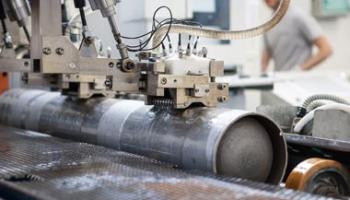
CYLINDER ULTRASONIC TEST
The only Company in Italy to perform ultrasonic test.
For the highest levels of safety and according to the ADR standard.
The cylinder ultrasonic test, is considered an alternative check to the usual hydraulic test provided for in the ADR regulation applicable during the periodic review.
The checks carried out are the result of a strictly regulated and well-defined procedure and provide a mechanized control of 100% of the cylindrical surface and a manual control of the critical and transition areas of both the bottom and the ogive.
For these checks Blugas can use a state-of-the-art machinery whose electronics, whose hardware and control methods have been developed on the basis of multi-decade experiences gained by the supplier in the context of controls exercised during the construction of cylinders and tubes, and an experience of more than ten years gained directly by our technicians in the periodic review of the ultrasonic cylinders with previous generation machinery.
The whole system fully complies with the European and international technical standards applicable and recognized by the ADR and has been certified by third parties.
Why ultrasonic?
Safety at the highest levels
Any defect in the material, even those not recognizable to the eye from the outside or through an internal visual inspection, is always detected and recorded.
Native internal defects of materials or defects arising as a result of stress can be detected by the ultrasonic before they become dangerous for the safety of the vessel.
This control becomes particularly effective in the periodic checks of receptacles built in not recent times for which the control with the same method was not foreseen at the time of construction.
Lack of stress
Ultrasonic inspections, which by definition excludes pressure control, avoids subjecting the cylinders to unnecessary stress to the material resulting from pressurization at the test pressure, which is higher than the normal operating pressure.
Lack of contamination
No foreign fluids come into contact with the inner wall of the cylinder during periodic testing. This aspect is particularly important in the case of cylinders destined to contain pure and ultra pure gases where the contact also with drinking water can condition the cylinder in a negative and irreversible way for the specific use made of it. It is also interesting for cylinders with lower safeguard requirements but for which the absence of internal contamination translates into a saving of time and money for the conditioning activities at the first filling.
The cylinder ultrasonic test, is considered an alternative check to the usual hydraulic test provided for in the ADR regulation applicable during the periodic review.
The checks carried out are the result of a strictly regulated and well-defined procedure and provide a mechanized control of 100% of the cylindrical surface and a manual control of the critical and transition areas of both the bottom and the ogive.
For these checks Blugas can use a state-of-the-art machinery whose electronics, whose hardware and control methods have been developed on the basis of multi-decade experiences gained by the supplier in the context of controls exercised during the construction of cylinders and tubes, and an experience of more than ten years gained directly by our technicians in the periodic review of the ultrasonic cylinders with previous generation machinery.
The whole system fully complies with the European and international technical standards applicable and recognized by the ADR and has been certified by third parties.
Why ultrasonic?
Safety at the highest levels
Any defect in the material, even those not recognizable to the eye from the outside or through an internal visual inspection, is always detected and recorded.
Native internal defects of materials or defects arising as a result of stress can be detected by the ultrasonic before they become dangerous for the safety of the vessel.
This control becomes particularly effective in the periodic checks of receptacles built in not recent times for which the control with the same method was not foreseen at the time of construction.
Lack of stress
Ultrasonic inspections, which by definition excludes pressure control, avoids subjecting the cylinders to unnecessary stress to the material resulting from pressurization at the test pressure, which is higher than the normal operating pressure.
Lack of contamination
No foreign fluids come into contact with the inner wall of the cylinder during periodic testing. This aspect is particularly important in the case of cylinders destined to contain pure and ultra pure gases where the contact also with drinking water can condition the cylinder in a negative and irreversible way for the specific use made of it. It is also interesting for cylinders with lower safeguard requirements but for which the absence of internal contamination translates into a saving of time and money for the conditioning activities at the first filling.
NEWSLETTER
Would you like to
ask for more information? CONTACT US
ask for more information? CONTACT US
Branch in RIMINI
Via Cesare Pavese, 50
47853 Cerasolo Ausa di Coriano (Rn)
Tel. +39 0541 756867 | Fax +39 0541 729276
E-mail: commerciale@blugas.com
Via Cesare Pavese, 50
47853 Cerasolo Ausa di Coriano (Rn)
Tel. +39 0541 756867 | Fax +39 0541 729276
E-mail: commerciale@blugas.com
Branch in MILANO
Via Guglielmo Marconi, 19/21
20089 Rozzano (Mi)
Tel. +39 02 8256321
E-mail: milano@blugas.com
Via Guglielmo Marconi, 19/21
20089 Rozzano (Mi)
Tel. +39 02 8256321
E-mail: milano@blugas.com
Credits TITANKA! Spa








